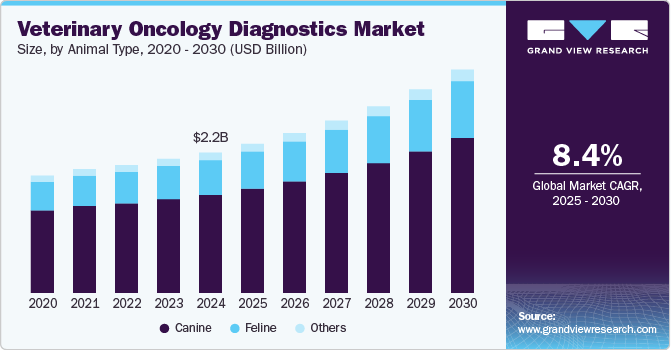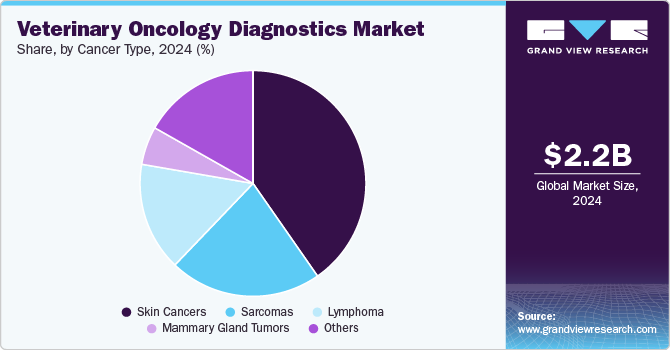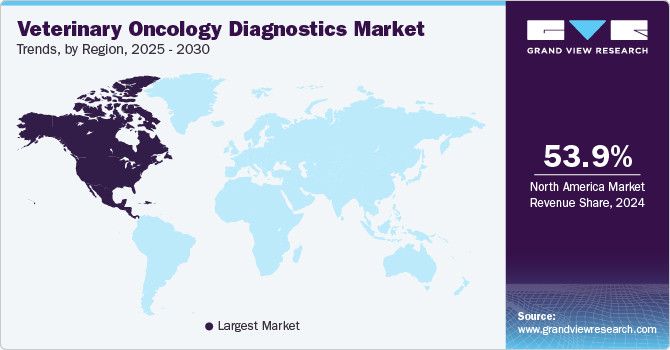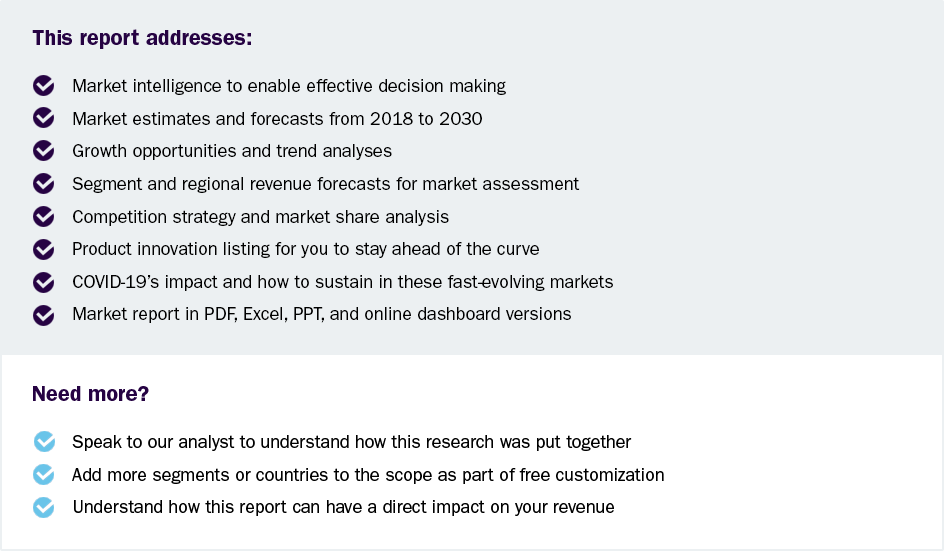
Veterinary Oncology Diagnostics Market Size, Share & Trends Analysis Report By Animal Type (Canine, Feline), By Test Type, By Cancer Type, By End-use, By Region, And Segment Forecasts, 2025 - 2030
- Report ID: GVR-4-68040-497-2
- Number of Report Pages: 150
- Format: PDF, Horizon Databook
- Historical Range: 2018 - 2023
- Forecast Period: 2025 - 2030
- Industry: Healthcare
Market Size & Trends
The global veterinary oncology diagnostics market size was estimated at USD 2.17 billion in 2024 and is projected to grow at a CAGR of 8.4% from 2025 to 2030. Key growth drivers include increasing the prevalence of cancer in pets, increasing R&D in early pet cancer diagnosis, and growing focus on animal safety. As per The Veterinary Cancer Society, Cancer is the top reason of death in 47% of canines, particularly those over 10 years old, and in 32% of felines. Around 1 in 4 dogs will experience abnormal tissue growth, or neoplasia, during their lifetime. With nearly 100 types of cancer affecting pets, a diagnosis can be overwhelming, yet advances in veterinary care have improved treatment success rates for both dogs and cats.

According to the American Animal Hospital Association, the most common cancers that have a higher prevalence in dogs include lymphoma, osteosarcoma, melanoma, and hemangiosarcoma. The article states that early cancer detection is critical to a pet's treatment and survival. Cancer is one of the most dreadful diseases that can occur in pets. Hence, there is an increased requirement for early pet cancer diagnosis to improve treatment options. For instance, according to the Merck Manual of Diagnosis and Therapy, cancer can completely and permanently be eradicated in the pet with the help of early disease diagnosis and treatment. Additionally, the growing awareness of early disease diagnosis for veterinary cancer patients and the increasing availability of effective diagnostic tools contribute to market growth.
The increasing research and development in veterinary oncology will drive market growth by improving pet cancer diagnosis solutions. Investments in cancer diagnosis and treatments for companion animals are also contributing to this growth. For example, in May 2024, The AKC Canine Health Foundation (CHF) invested $3.6 million in active cancer research, marking Canine Cancer Awareness Month. This includes pilot studies on canine melanoma and osteosarcoma, with the aim to develop innovative diagnostic tests and treatments that may also benefit human cancer research. CHF's ongoing support of molecular-level cancer studies and diagnostic advancements significantly improves veterinary oncology diagnostics.
Veterinary research organizations are also advancing the fight against pet cancer. In January 2024, the Morris Animal Foundation announced funding for eight new research grants to study various canine cancers, including lymphoma, bone cancer, and soft-tissue sarcomas. These studies aim to improve understanding, diagnosis, and treatment options for pet cancer, potentially benefiting both pets and humans. These ongoing R&D initiatives and investments by industry stakeholders are expected to drive significant growth in the veterinary oncology diagnostics market in the coming years.
Animal Type Insights
The canine segment held the largest revenue share of over 69.9% in 2024. This growth is due to the rising prevalence of cancer, growing awareness of early canine cancer diagnosis, and an increase in the development of advanced canine cancer diagnostics solutions. For instance, in June 2024, Oxford BioDynamics (OBD) developed the EpiSwitch Specific Canine Blood (SCB) test, a blood-based diagnostic that can detect six types of cancer in dogs. Using a 3D genomic approach, the test offers high accuracy and sensitivity, with results over 80% for most cancers. The test aims to improve cancer diagnosis, reduce unnecessary treatments, and help optimize veterinary care for cancer patients. In addition, the increasing pet dog population also contributes to the segment's growth. According to the National Canine Cancer Foundation, Cancer is the leading cause of death in senior dogs, with approximately 1 in 4 dogs expected to develop cancer during their lifetime.
The feline segment is anticipated to witness significant growth throughout the forecast period. This growth is primarily attributed to the rising population of cats worldwide and the apparent rise in the associated diseases. According to the International Fund for Animal Welfare (IFAW), over 220 million pet cats are worldwide. Similarly, according to the American Veterinary Medical Association (AVMA), the pet cat population in the U.S. is estimated to be 73.8 million in 2024. Furthermore, establishing research institutes and organizations dedicated to veterinary research helps researchers access data to understand pet cancer patterns. One such initiative is the Australian Companion Animal Registry of Cancers (ACARCinom). Founded in November 2023, ACARCinom aims to create a comprehensive national database for cancer occurrences in companion animals, specifically dogs and cats. Such initiatives are expected to drive the segment's growth in the coming years.
Test Type Insights
The biopsy segment dominated and had the largest market share in 2024. The rise in the development and launch of liquid biopsy tests by key players, enabling earlier and non-invasive cancer detection, contributes to segment growth. For instance, in February 2024, PetDx's newly validated OncoK9 Screen liquid biopsy test, published in JAVMA, offers over 70% sensitivity for detecting seven aggressive cancer types in dogs, including lymphoma and osteosarcoma, with a low false positive rate (<1.5%). This lower-cost, faster alternative to the OncoK9 Dx test uses cfDNA quantification and next-generation sequencing to improve early cancer detection during routine wellness visits. With its affordability and accessibility, the test enhances preventive care and contributes to developing standardized cancer screening protocols for dogs.
The genome testing segment is anticipated to witness exponential growth of over 9.5% throughout the forecast period. The demand for genetic and genome-based veterinary cancer diagnostic testing is growing due to its ability to provide early, accurate, and non-invasive detection, offering personalized treatment options and improving outcomes for pets with cancer. For instance, in February 2024, Virginia Tech researchers developed a novel, non-invasive urine-based cancer screening test for dogs using Raman spectroscopy. This rapid, cost-effective method detects unique cancer "fingerprints" with over 90% accuracy, surpassing traditional blood tests. The technology, still in clinical trials, holds promise for early cancer detection, monitoring treatment response, and evaluating tumor recurrence, with potential applications across veterinary and human health. By enabling early detection and monitoring of canine cancer, it addresses critical gaps in cost, speed, and noninvasiveness, paving the way for broader adoption and future market growth.
End-use Insights
Based on end use, the veterinary hospitals & clinics segment held the largest share of 61.75% in 2024. The veterinary hospitals and clinics segment holds the highest market share due to the high demand for rapid, accurate diagnostics in routine care for companion animals. Additionally, the increased availability of in-clinic cancer diagnostic solutions contributes to segment growth. For instance, in April 2024, VolitionRx launched its Nu.Q Vet Cancer Test in collaboration with Antech, providing veterinarians in the U.S. and Europe with a rapid, cost-effective, in-clinic screening tool for canine cancer. The test, available on the Element i+ Analyzer, delivers results within six minutes, enabling early cancer detection, particularly in high-risk breeds and senior dogs. This innovation is set to enhance in-clinic pet cancer diagnosis by offering faster, accessible, and affordable cancer screening during routine check-ups.
The reference Laboratories segment is expected to grow significantly over the forecast period due to increasing demand for specialized, high-throughput veterinary cancer diagnostic services from veterinary clinics and hospitals. Advances in molecular diagnostic technologies and a growing emphasis on comprehensive disease detection and surveillance drive the need for sophisticated, centralized testing facilities that can offer more precise and diverse diagnostic capabilities. Recent advancements in veterinary oncology include new cancer screening tools, such as the Nu.Q blood test, Oncotect urine test, and CADET BRAF test, which enhance diagnostic capabilities for veterinary reference laboratories and contribute to segment growth. The Nu.Q Vet Cancer Test is now accessible through IDEXX's reference laboratory network.
Cancer Type Insights
Skin cancer held the largest share of the market in 2024, and it is expected to grow at the fastest CAGR of 8.6% during the forecast years. This growth can be attributed to the prevalence of squamous cell carcinoma in cats & dogs, and skin tumors are the most typical form of cancer in older dogs. For instance, according to research published in the PubMed Central Journal in April 2023, 56% of the total malignant tumors in dogs were found in the skin. Similarly, 69% of benign tumors were skin cancers. In cats, squamous cell carcinoma (SCC) commonly occurs in facial areas. However, it can happen anywhere, including the toes. For instance, the SCC of the toes comprises around 25% of all cat digital tumors. Mast cell tumors (MCTs) are the third most common type of tumor found in dogs, accounting for 11% of skin cancer cases. Thus, the rising prevalence of skin cancers in pets and the demand for early diagnosis fuel market growth.

The others segment is expected to grow the most over the forecast period, with a CAGR of 8.47% during the forecast period. The others segment comprises adenocarcinomas (e.g., anal sac adenocarcinoma), brain tumors, nasal tumors, oral tumors, and other cancers. The rising prevalence of various animal cancers boosts the demand for advanced veterinary cancer diagnostics. For instance, according to the article by MDPI in July 2024, the incidence of pulmonary carcinoma (PPC) is the highest in primary lung cancer among dogs. Under pulmonary carcinoma, the most common histological subtype is pulmonary adenocarcinoma, which accounts for 60-80% of incidences.
Regional Insights
North America accounted for the largest revenue share of over 53.9% in 2024. One of the primary drivers of market growth is the growing number of veterinary cancer care clinics in this region. In August 2019, for example, VCA Animal Hospitals opened 35 cancer centers around North America. A comprehensive oncology team with cancer diagnosis and treatment expertise worked at the sites. The market is predicted to develop due to hospital-led activities in this industry. Additionally, the region's need for oncology care is being increased by the expanding strategic initiatives by major companies to expand access to advanced diagnostic solutions for pet cancer in North America.

U.S. Veterinary Oncology Diagnostics Market Trends
The U.S. veterinary oncology diagnostics market is witnessing growth due to the increasing prevalence of cancer in pets, particularly dogs. The National Cancer Institute estimates that an estimated 6 million dogs receive a cancer diagnosis each year, and a similar number of cats receive a cancer diagnosis, according to preliminary estimates of cancer incidence. This rise in cancer cases, driven by factors like aging pets and genetic predispositions, has increased the demand for advanced diagnostic tools. The development of new tests in June 2024, such as the EpiSwitch Specific Canine Blood Test, which can detect multiple types of cancer in dogs, is further propelling the market. These innovations enable earlier and more accurate diagnosis, improving treatment outcomes and driving the adoption of veterinary oncology diagnostics across the U.S.
Europe Veterinary Oncology Diagnostics Market Trends
The Europe veterinary oncology diagnostics market is growing due to increasing pet ownership, higher awareness of animal cancer, and the adoption of advanced diagnostic technologies. The rising prevalence of cancer in pets, particularly in older dogs and high-risk breeds, is driving demand for early detection tools. Notable developments include the launch of the Nu.Q Canine Cancer Test in Europe by Antech, which offers rapid and accurate screening for canine cancers. This trend is supported by veterinary professionals' growing emphasis on early diagnosis to improve pet health outcomes.
The UK veterinary oncology diagnostics market is set to witness lucrative growth due to the highest pet populations and pet-related spending rates. Additionally, a high rate of medicalization, increasing pet humanization, enhanced diagnostics, and an increasing number of veterinary clinics providing oncology care all contribute to the substantial market across the country. Moreover, Market growth is anticipated to be supported by a number of measures taken by industry participants to increase diagnostic rates. For example, in November 2023, Veterinary Pathology Group and VolitionRx Limited collaborated to introduce the Nu.Q Vet Cancer Test to identify and track cancer in dogs in the UK and Ireland.
Veterinary oncology diagnostics market in Germany is growing due to rising incidence of animal cancer in the Germany. A National Library of Medicine report from October 2022 states that 109,616 German dog tissue samples' pathological datasets were processed and statistically analyzed. 70,966 samples (64.7%) had neoplasms diagnosed, whereas 38,650 samples (35.3%) had non-neoplastic diseases. The most common neoplasms were odontogenic tumors (4.7%), melanocytic tumors (5.2%), mast cell tumors (9.7%), soft tissue sarcomas (5.8%), lipomas (5.8%), benign skin tumors (15.4%), histiocytomas (7.0%), and breast cancers (21.9%). As cancer rates in pets increase, pet owners seek effective diagnostic solutions to improve their pets' quality of life. This demand has led to advancements in veterinary oncology, with new diagnostic tools and treatment options becoming more accessible.
Asia Pacific Veterinary Oncology Diagnostics Market Trends
The Asia Pacific Veterinary Oncology Diagnostics Market is expanding rapidly due to increasing awareness of animal cancer and a rising number of cases, particularly in countries like India. According to a 2024 article in the International Journal of Biological and Environmental Investigations, India has seen a sharp increase in domestic animal cancer cases, especially in dogs and cats. This growing demand for early diagnosis and advanced treatments is driving the market. Furthermore, collaborations like the one between Cancan Diagnostics and Vet Planet Ltd. are helping expand access to cutting-edge diagnostic tools across the region.
The Japan Veterinary Oncology Diagnostics Market is witnessing significant growth, fueled by collaborations between global leaders in veterinary diagnostics. For instance, in March 2024, VolitionRx's partnership with Fujifilm Vet Systems introduced the Nu.Q Vet Cancer Test to Japanese veterinarians, offering a simple and cost-effective blood screening tool for early cancer detection in dogs. Such partnerships enable faster adoption of advanced diagnostic technologies, improving cancer care and driving market expansion in Japan. Additionally, Japan's growing demand for early detection and preventive care further contributes to the market's development.
Latin America Veterinary Oncology Diagnostics Market Trends
The Latin America veterinary oncology diagnostics market is growing rapidly, driven by international collaboration and advancements in cancer detection, diagnosis, and treatment. Conferences like the International Conference on Advances in Veterinary Oncology in Argentina foster global knowledge exchange, enabling veterinarians to adopt innovative practices and treatments. This exchange accelerates the adoption of novel diagnostic tools, improving early cancer detection and survival rates, thus driving the market forward. The involvement of global experts and the introduction of advanced diagnostics are pivotal in enhancing veterinary oncology practices across the region.
Brazil veterinary oncology diagnostics market is growing due to theaccessibility of advanced diagnostic tools and services. For example, companies like IDEXX and Antech are establishing local partnerships and distribution networks, ensuring rapid availability of diagnostic tests like Nu.Q and CADET BRAF for canine cancer. This accessibility improves early detection and treatment options for pets while also fostering local industry growth and collaboration between veterinary clinics and diagnostic laboratories.
MEA Veterinary Oncology Diagnostics Market Trends
The veterinary oncology diagnostics market in MEA is estimated to witness lucrative growth over the forecast period. The market is growing due to the expanding availability of specialist veterinary oncology diagnosis services and surgical options. Veterinary specialists in the region are becoming more knowledgeable about oncology, increasing the provision of high-quality care. The availability of high-quality diagnostic tools and equipment such as imaging technologies such as CT scans, MRIs, and radiation therapy machines in the MEA region enhances the accuracy and success rates of oncology diagnosis in animals.
The South African veterinary oncology diagnostics market is growing due to increasing pet ownership, rising awareness of animal cancer, and advancements in diagnostic technology. The demand for early cancer detection tools, such as blood tests and imaging technologies, is on the rise, driven by an increase in pet cancer cases and a greater emphasis on preventive healthcare. Companies like Antech and VolitionRx are expanding their regional presence, offering diagnostic tools tailored to local veterinary practices, further fueling market growth.
Key Veterinary Oncology Diagnostics Company Insights
Major players operating in the market are involved in various strategies such as distribution agreements, mergers & acquisitions, and expansions. Most crucially, they exhibit a very high degree of innovation in product research & development to improve their market penetration.
Key Veterinary Oncology Diagnostics Companies:
The following are the leading companies in the veterinary oncology diagnostics market. These companies collectively hold the largest market share and dictate industry trends.
- Zoetis
- Antech Diagnostics, Inc. (Mars Inc.)
- IDEXX Laboratories, Inc.
- Neogen Corporation
- Gold Standard Diagnostics (Eurofins Technologies)
- Embark Veterinary, Inc.
- VolitionRx Limited
- CANCAN DIAGNOSTICS
- Oncotect
- PetDx
Recent Developments
-
In December 2024, Torigen Pharmaceuticals launched Torigen Specialty Pathology, a service providing fast, expert-reviewed cancer diagnostics for pets. Offering 3-to-5 day turnaround times and clear, actionable reports, the service supports veterinarians in making timely and informed treatment decisions. It also integrates seamlessly with Torigen’s personalized cancer immunotherapy options.
-
In September 2024, Cancan Diagnostics partnered with Vet Planet Ltd. to distribute its innovative canine cancer diagnostic tool, K9-LiquiDX, across Mainland Europe, APAC, the Middle East, and South America. This collaboration aims to enhance early cancer relapse detection and support the monitoring of canine cancer, expanding access to advanced diagnostics for veterinarians worldwide.
-
In April 2024, Antech launched the Nu.Q Canine Cancer Test in Europe, a rapid and accurate screening tool for detecting common cancers like lymphoma and hemangiosarcoma in dogs. This test, designed for in-clinic use, provides results in just 5-10 minutes, enabling veterinary professionals to make timely decisions and improve cancer care outcomes for high-risk dogs.
-
In March 2024, VolitionRx collaborated with Fujifilm Vet Systems to launch the Nu.Q Vet Cancer Test in Japan. This collaboration allows Fujifilm Vet Systems to offer cancer screening services for dogs through its network of reference laboratories, enabling early detection and improved patient care across Japan.
Veterinary Oncology Diagnostics Market Report Scope
|
Report Attribute |
Details |
|
Market size value in 2025 |
USD 2.31 billion |
|
Revenue forecast in 2030 |
USD 3.45 billion |
|
Growth rate |
CAGR of 8.4% from 2025 to 2030 |
|
Base year for estimation |
2024 |
|
Historical data |
2018 - 2023 |
|
Forecast period |
2025 - 2030 |
|
Quantitative units |
Revenue in USD million/billion and CAGR from 2025 to 2030 |
|
Report coverage |
Revenue forecast, company ranking, competitive landscape, growth factors, and trends |
|
Segments covered |
Animal Type, test type, cancer type, end-use, region |
|
Regional scope |
North America; Europe; Asia Pacific; Latin America; MiddleEast and Africa |
|
Country scope |
U.S.; Canada; Mexico; Germany; France; UK; Italy; Spain; Denmark; Sweden; Norway; Japan; China; India; Australia; South Korea; Thailand; Brazil; Argentina; South Africa; Saudi Arabia; UAE; Kuwait |
|
Key companies profiled |
Zoetis; Antech Diagnostics, Inc. (Mars Inc.); IDEXX Laboratories, Inc.; Neogen Corporation; Gold Standard Diagnostics (Eurofins Technologies); Embark Veterinary, Inc.; VolitionRx Limited; CANCAN DIAGNOSTICS; Oncotect; PetDx |
|
Customization scope |
Free report customization (equivalent up to 8 analysts working days) with purchase. Addition or alteration to country, regional & segment scope. |
|
Pricing and purchase options |
Avail customized purchase options to meet your exact research needs. Explore purchase options |
Global Veterinary Oncology Diagnostics Market Report Segmentation
This report forecasts revenue growth at global, regional, and country levels and provides an analysis of the latest industry trends in each of the sub-segments from 2018 to 2030. For this study, Grand View Research has segmented the global veterinary oncology diagnostics market report based on animal type, test type, cancer type, end-use and region:
-
Animal Type Outlook (Revenue, USD Million, 2018 - 2030)
-
Canine
-
Feline
-
Others
-
-
Test Type Outlook (Revenue, USD Million, 2018 - 2030)
-
Blood Tests
-
Biopsy
-
Genome Testing
-
Endoscopy
-
Urinalysis
-
Imaging
-
-
Cancer Type Outlook (Revenue, USD Million, 2018 - 2030)
-
Lymphoma
-
Sarcomas
-
Mammary Gland Tumors
-
Skin Cancers
-
Others
-
-
End-use Outlook (Revenue, USD Million, 2018 - 2030)
-
Reference Laboratories
-
Veterinary Hospitals & Clinics
-
-
Regional Outlook (Revenue, USD Million, 2018 - 2030)
-
North America
-
U.S.
-
Canada
-
Mexico
-
-
Europe
-
UK
-
Germany
-
France
-
Italy
-
Spain
-
Denmark
-
Sweden
-
Norway
-
Rest of EU
-
-
Asia Pacific
-
Japan
-
China
-
India
-
Australia
-
South Korea
-
Thailand
-
Rest of APAC
-
-
Latin America
-
Brazil
-
Argentina
-
Rest of LA
-
-
Middle East and Africa
-
South Africa
-
Saudi Arabia
-
UAE
-
Kuwait
-
Rest of MEA
-
-
Frequently Asked Questions About This Report
b. The global veterinary oncology diagnostics market size was estimated at USD 2.17 billion in 2024 and is expected to reach USD 2.31 billion in 2025.
b. The global veterinary oncology diagnostics market is expected to grow at a compound annual growth rate of 8.40% from 2025 to 2030 to reach USD 3.45 billion by 2030.
b. North America dominated the veterinary oncology diagnostics market with a share of 53.90% in 2024. This is attributable to the growing number of veterinary cancer care clinics and the increasing prevalence of cancer in pets, particularly dogs.
b. Some key players operating in the veterinary oncology diagnostics market include Zoetis, Antech Diagnostics, Inc. (Mars Inc.), IDEXX Laboratories, Inc., Neogen Corporation, Gold Standard Diagnostics (Eurofins Technologies), Embark Veterinary, Inc., VolitionRx Limited, CANCAN DIAGNOSTICS, Oncotect, PetDx.
b. Key factors that are driving the market growth include increasing the prevalence of cancer in pets, increasing R&D in early pet cancer diagnosis, and growing focus on animal safety.
We are committed towards customer satisfaction, and quality service.
"The quality of research they have done for us has been excellent."




